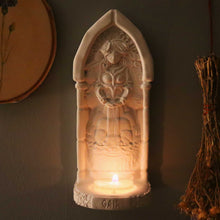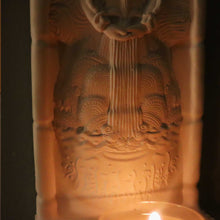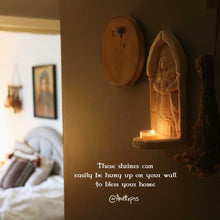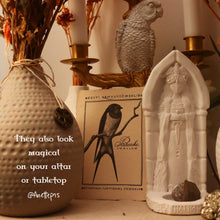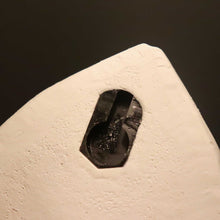
Handmade with love in Estonia, available in limited quantity.
This small shrine can be hung on your wall to bless your home, or placed on any table-top, whether it be your tv table, next to your bed, or anywhere else!
The engraved circle in front is suitable for a standard tea-candle. You can also place water or other offerings there, the possibilities are endless!
Size:
Width: 8cm / 3 inches
Height: 20cm / 8 inches
Candle holder part: reaches out by 7.5cm / 3 inch
Made from high quality plaster that looks and feels like clay.
—
Gaia is Earth and Gaia is the Goddess. In the beginning, before anything existed, there was Chaos; the void. Gaia, the Earth, emerged from Chaos and formed the sea (Pontus) and the sky (Uranus) from her own body. Thus begins an ancient Greek creation saga. It is the point from which virtually every general Greek mythology book begins.
• Hesiod’s version of Creation skips right over the part with Chaos and starts with Gaia.
• Gaia is praised in the Homeric Hymns to Ge as the oldest of divinities.
Gaia and Uranus become lovers and generate more beings (the Titans and Cyclopes, for instance). Following their separation, Gaia begat more children with Pontus. Gaia is literally the Earth: you can stand on her, but she is an active goddess with a personality, too. She is not a goddess of agriculture (that’s Demeter). Instead she is the spirit of the wild, sacred Earth containing untold treasure and potential.
Gaia is devoted to all her children, accepting them as they are, unlike the many fathers (Uranus, Kronos, Zeus) of Greek mythology who prey upon their heirs and seek to suppress them. Gaia battles with gods on behalf of her children.
This mythic Gaia is based on the cosmologies of Greece and southern Italy, regions highly prone to earthquakes, where Earth is experienced as an active, living presence. She is not static or motionless but very much alive. Earthquakes may be perceived as expressions of divine anger, but they also physically resemble birthing contractions. I lived at the epicenter of the 1994 Northridge, California, earthquake just four months after giving birth and can personally vouch for the resemblance between aftershocks and labour contractions.
Gaia is an ever-present spirit of justice. She is never absent. Greek citizens swore public oaths to her. Shrines were dedicated to her; they were built near deep chasms, believed to be the most accessible place to communicate with her. Her shrines were associated with oracles such as those at Delphi, Athens, and Aegae (Macedonia). Delphi was the most famous oracle of the ancient world: Gaia’s priestesses, known as pythonesses, prophesied after inhaling vapors emerging from a fissure in Gaia. Essentially, they spoke directly with her. The oracular spirit Apollo staged a coup, slaying the shrine’s sacred serpent and installing himself as deity in charge. However, even after Delphi was rededicated to Apollo, the pythoness began her formal address to the deities with the words, “First in my prayer before all other deities, I call on Earth, primeval prophetess.”
The Greek-influenced Russian Church officially places Gaia under the dominion of the Creator. According to a Russian folk legend, Gaia complained bitterly to the Creator about the pain humanity causes her. The Creator advised her not to cry as “in the end, you’ll eat them all.”










